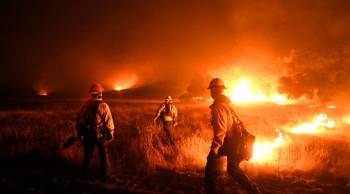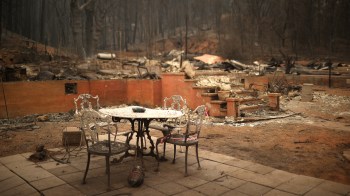Fireproofing your home in the wilderness
Hundreds of homes have already been lost to this year’s destructive Western wildfire season. But experts say some of those homes could have been spared, if the owners had been willing to do the difficult and expensive work of protecting them.
Keith Worley has been preaching the gospel of fire mitigation for decades to anyone who’ll listen. Living in a rural development in the foothills southwest of Denver, he knows firsthand the dangers of fire.
A decade ago, with the Hayman wildfire bearing down on his neighborhood, Worley helped a fire crew map out its strategy for protecting homes. The firefighters color-coded each house either green, yellow, or red. Green houses might be saved, yellow were tougher. As for the red houses, Worley remembers the fireman with him joking that those as “historic.”
“For him, the red meant, ‘It’s history’,” Worley says.
Those were homes that hadn’t taken the basic safety precautions that might be crucial during a fire. Things like clearing brush, thinning trees, and installing rocky, fireproof landscaping around foundations. Modifications like that can run into the thousands of dollars. Worley’s heard every excuse in the books for why a homeowner doesn’t want to make them.
“’Number one: I pay my taxes and when I dial 911 I expect the fire department to be here,’” Worley says. “’Number two, I’ve got insurance, and so if this burns down I’m going just replace it.’”
Worley says privacy is also a big concern. Many people move to the forest for seclusion, and mistakenly believe that mitigation would require them to clear-cut their property.
Those stubborn homeowners may find not mitigating to be an increasingly expensive proposition, though. Insurance companies, tired of absorbing wildfire losses, are starting to consider fire risk before they write or renew policies.
“Insurers are increasingly requiring homeowners to share that risk and do the mitigation to make their property safer, and to make it insurable,” says Carole Walker. She’s president of the Rocky Mountain Insurance Information Association.
Those requirements can include things like removing trees or replacing a wooden deck with concrete. But Walker thinks insurance companies on their own shouldn’t have to bear all the responsibility for getting homeowners to protect themselves.
“The larger public policy question is, what are we doing as a community to make sure that we’re trying to get people to do the right thing?” Walker asks.
In Colorado, more of those fire-prone communities are pushing developers to build in safety measures. One such effort looks like it paid off during the devastating Black Forest Fire last month. Its flames mostly spared the neighborhood of Cathedral Pines, a recent development designed to be fire-safe. Nearby, many older homes – built before these considerations – weren’t so lucky.
Getting those safety measures in Cathedral Pines took some negotiation, though. That’s because mandatory mitigation is rarely popular, according to Roger Lovell with the Pikes Peak Regional Building Department.
Looking out the window of a bus during a recent media tour of the Black Forest Fire destruction, Lovell adds, “Until recently, I’d say that a number of people didn’t exactly understand why that request was being made, too.”
But the message does seem to be getting through. Mitigation specialist Keith Worley says he usually stops getting calls about fire safety as soon as the summer smoke clears. But this past winter, his phone just kept on ringing.
There’s a lot happening in the world. Through it all, Marketplace is here for you.
You rely on Marketplace to break down the world’s events and tell you how it affects you in a fact-based, approachable way. We rely on your financial support to keep making that possible.
Your donation today powers the independent journalism that you rely on. For just $5/month, you can help sustain Marketplace so we can keep reporting on the things that matter to you.


















